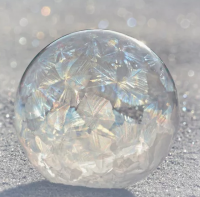Weather -- School-Age
Ice/Snow
Crystals
Need: salt(rock, kosher, table, epsom), magnifying glass, black paper, paper and pencils.
Let children examine substances that, like snowflakes, have six sides. When examining salt with a magnifying glass, it is more easily seen on a dark surface, such as black construction paper.
After children have examined the different substances have them draw (in a science journal) each of the different types of crystals they observed.
Making Frost
Need: tin can without a lid, rock salt, crushed ice.
Put 2 cups of crushed ice and 1/2 cup rock salt in a can.
Stir the mixture rapidly. This needs to sit about 30 minutes.
After 30 minutes the outside of the can will have dew on it. If you wait a while longer, this dew will change to frost.
Talk about where the dew came from and how it was formed. Also, talk about the dew changing to frost. As the can cools, the moisture in the air condenses on the cool surface. As the can becomes colder, the water on the surface of the can freezes causing the formation of frost.
Blizzard in a Bag (easy)
Winter Science Experiments: How Much Water is in Snow?
Hockey Science Experiment What will slide on ice?
Rain
Measure the Rain
Need: ruler and marker, measuring cup, small clear bottle, large clear plastic bottle (2 liter pop bottle works great).
Cut the tops off both bottles.
Take a measuring cup and fill 1/4 cup full. Pour this water into the small bottle and mark the level. Do this several times so that you have a series of marks on the side of the small bottle. Empty the small bottle and place it inside the large bottle. Put the top of the large bottle upside down over the small bottle. It forms a funnel
Stand the bottles outside to catch the rain. Record the water level in the small bottle each morning. This is the daily rainfall.
Add up the rainfall for each week or each month. Then make a chart to show how much rain falls over several weeks, months, or even a whole year.
Storms
Tornado in a Jar
Need: tall plastic jar (pop bottle), 4 to 6 small balls of aluminum foil, clear liquid soap, water, blue food coloring.
Place a teaspoon (5ml) of clear liquid soap in your plastic container. Drop into the jar 3-4 vary small pieces of aluminum foil rolled into balls. The foil should be folded and pressed so that it will sink. Fill the jar to the top with water. Add 1 to 2 drops of blue food coloring.
Rotate the container and a swirling effect should be produced. It may take some practice. Set the container up on the table and watch. The force of the foil at the bottom should keep the water in motion. The action resembles the motion set up as circular rotations of air in the atmosphere form a tornado.
Thunder Science Experiment using a bag.
Wind
Blowing in the Wind
Need: cardboard, string, vegetable oil or petroleum jelly
Using a piece of cardboard that is the size of notebook paper or larger. Make a small hole on one end of the cardboard, and tie a piece of string through the hole. Smear one side of the cardboard with vegetable oil or petroleum jelly.
On a windy day, hang the cardboard from a tree using the string. Make sure the oily side of the cardboard is facing the wind. Leave the cardboard in the wind for an hour or more. Then go back and see what the wind has carried onto the cardboard.
Learn about hurricanes and make a hurricane spiral.
Build an anemometer an instrument used to measure wind speed.
Sites to See
Weather Whiz Kid - Information, games, experiments.






